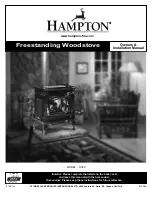
10
6.
For
the
installer
Finally,
before
firing
the
stove
the
first
time
a
check
should
be
made
to
ensure
that
the
assembly
and
stove
installation
has
been
satisfactory
and
that
there
are
no
leaks
in
any
seals
in
the
appliance
and
appliance
connections
to
the
chimney.
Ensure
that
the
appliance
and
the
chimney
flue
are
functioning
correctly
before
finally
handing
over
to
the
user.
If
necessary
read
the
later
parts
of
this
manual
for
guidance
on
care
required
when
first
lighting.
Inform
the
user
that
the
appliance
has
been
commissioned
and
ready
to
use
and
give
instruction
on
the
safe
operation
of
the
stove.
These
instructions
must
be
left
with
the
user
and
the
user
should
be
instructed
to
keep
them
in
a
safe
place.
6.1
Operating
instructions
Please
note
that
the
appliance
approval
only
covers
the
use
of
dry
seasoned
wood
logs
on
this
appliance.
This
approval
does
not
cover
the
use
of
other
fuels
either
alone
or
mixed
with
the
wood
logs
nor
does
it
cover
instructions
for
the
use
of
other
fuels.
6.1.1
Fuel
The
stove
is
designed
and
approved
in
accordance
with
AS/NZS
4012/4013
and
AS/NZS
2918
‐
2001
Appendix
B
for
stocking
dried
firewood.
The
firewood
must
have
a
water
content
of
15
–
22
%
and
it
maximum
length
should
be
the
width
of
the
combustion
chamber
minus
50
–
60
mm.
Stocking
with
wet
firewood
causes
both
soot
and
environmental
pollution
and
is
bad
fuel
economy.
Freshly
cut
wood
contains
approx.
50
–
70
%
water
and
is
thoroughly
unsuitable
for
stocking.
Count
min.
1
year
of
storage
time
for
newly
cut
wood
before
using.
Wood
with
a
diameter
of
no
more
than
100
mm
should
be
split.
Regardless
of
wood
size,
it
should
always
have
at
least
one
surface
area
free
of
bark.
The
following
fuels
are
prohibited
and
must
not
be
used:
Painted,
laminated
or
treated
(impregnated)
wood,
wood
with
a
synthetic
surface,
painted
refuse
wood,
chipboard,
plywood,
domestic
waste,
paper
briquettes
and
pit
coal,
as
this
will
produce
malodorous
smoke,
which
could
be
poisonous.
The
use
of
such
fuels
may
damage
the
appliance
and
will
void
the
warranty.
When
firing
with
the
above
mentioned
items
and
the
amounts
larger
than
those
recommended,
the
stove
is
subjected
to
a
larger
amount
of
heat,
which
results
in
a
higher
chimney
temperature
and
lower
efficiency.
This
can
result
in
the
stove
and
chimney
becoming
damaged
and
would
void
the
warranty.
Содержание RAIS
Страница 24: ...24 2 Legend for the spare parts...
Страница 25: ...25 3 Technical drawing of the bionic fire...











































